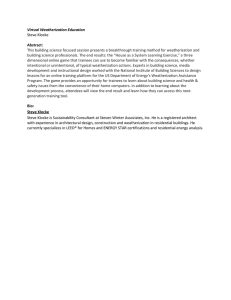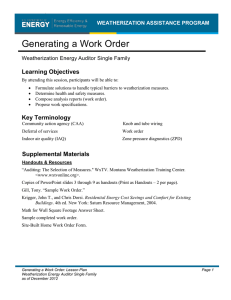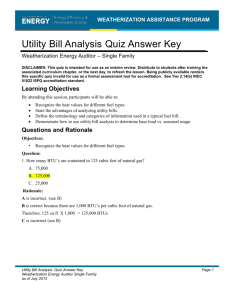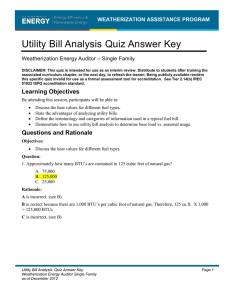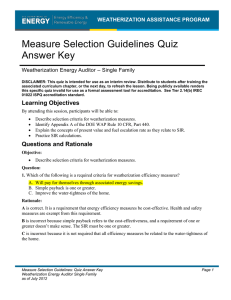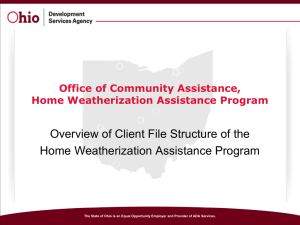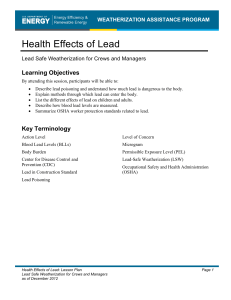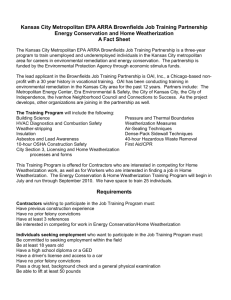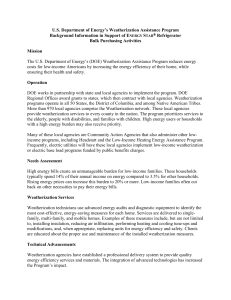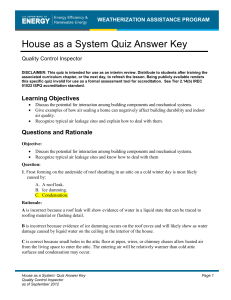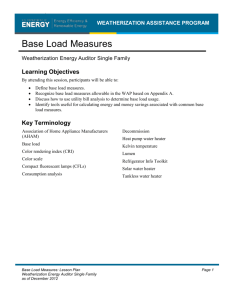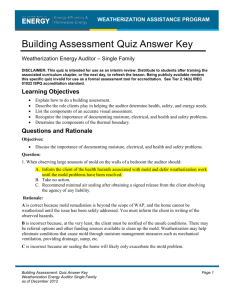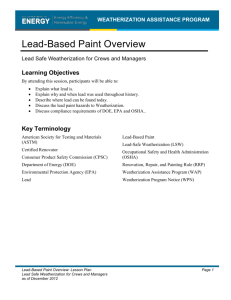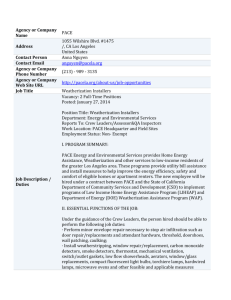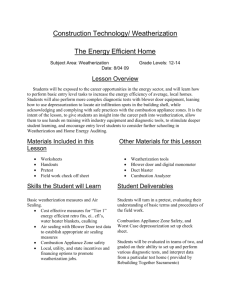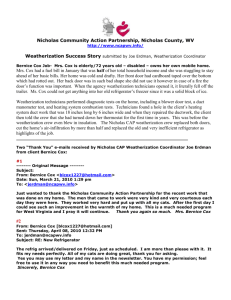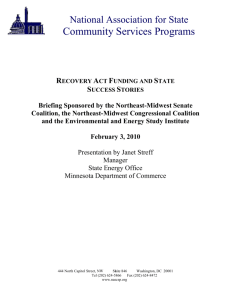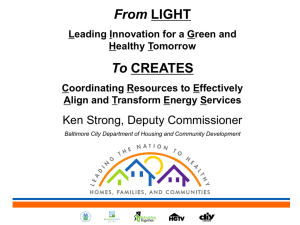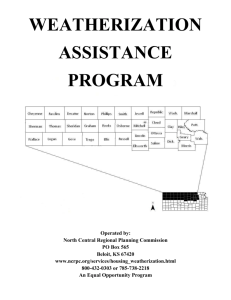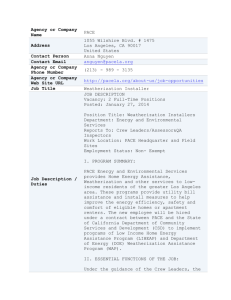Quiz Key Introduction to Weatherization
advertisement
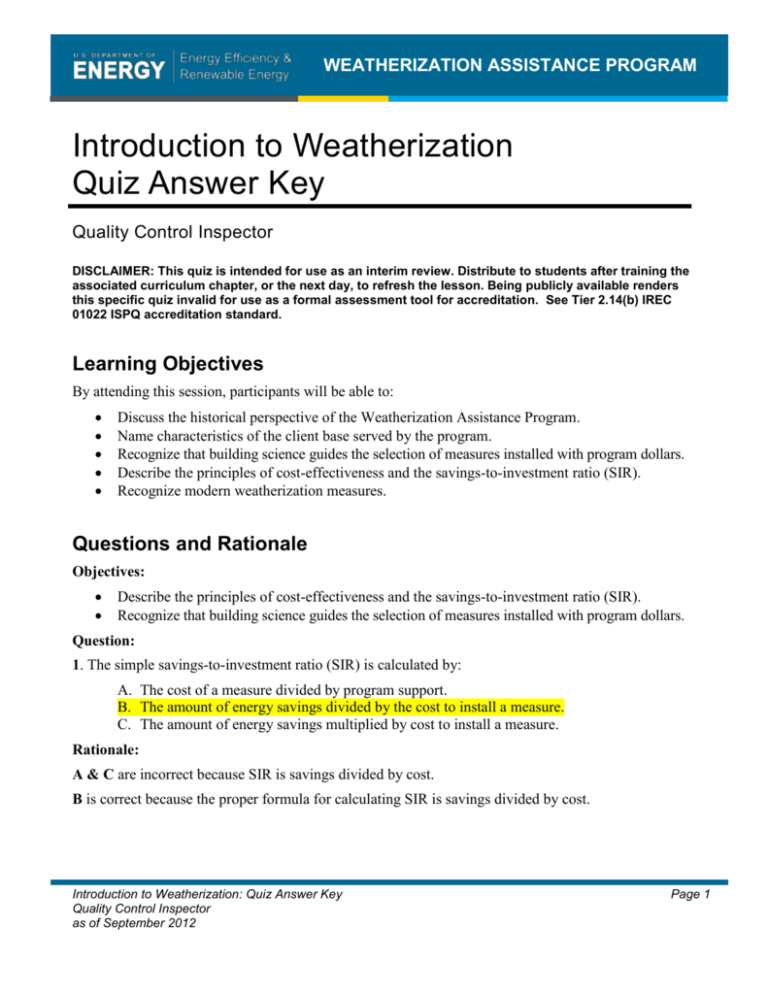
WEATHERIZATION ASSISTANCE PROGRAM Introduction to Weatherization Quiz Answer Key Quality Control Inspector DISCLAIMER: This quiz is intended for use as an interim review. Distribute to students after training the associated curriculum chapter, or the next day, to refresh the lesson. Being publicly available renders this specific quiz invalid for use as a formal assessment tool for accreditation. See Tier 2.14(b) IREC 01022 ISPQ accreditation standard. Learning Objectives By attending this session, participants will be able to: Discuss the historical perspective of the Weatherization Assistance Program. Name characteristics of the client base served by the program. Recognize that building science guides the selection of measures installed with program dollars. Describe the principles of cost-effectiveness and the savings-to-investment ratio (SIR). Recognize modern weatherization measures. Questions and Rationale Objectives: Describe the principles of cost-effectiveness and the savings-to-investment ratio (SIR). Recognize that building science guides the selection of measures installed with program dollars. Question: 1. The simple savings-to-investment ratio (SIR) is calculated by: A. The cost of a measure divided by program support. B. The amount of energy savings divided by the cost to install a measure. C. The amount of energy savings multiplied by cost to install a measure. Rationale: A & C are incorrect because SIR is savings divided by cost. B is correct because the proper formula for calculating SIR is savings divided by cost. Introduction to Weatherization: Quiz Answer Key Quality Control Inspector as of September 2012 Page 1 WEATHERIZATION ASSISTANCE PROGRAM Objectives: Discuss the historical perspective of the Weatherization Assistance Program. Question: 2. A feature of the weatherization program that was not typical nationwide in the early1990s was: A. Comprehensive diagnostic technology. B. Structured training and technical assistance. C. Health and safety plans in place. Rationale: A is correct. In the 1980s the availability of equipment and/or adequate training was limited. B is incorrect. Structured training and technical assistance became more formalized and common in the 1990s. C is incorrect. Typical of the 1990s through present. Objectives: Recognize that building science guides the selection of measures installed within program dollars. Question: 3. Which of the following BEST identifies the criteria for selection of measures to be installed in a home with WAP funds?: A. Cost-effectiveness based on building science and energy prices. B. Availability of fiberglass or cellulose insulation for dense-packing. C. Skill and resources of local crews/contractors. Rationale: A is correct. These are what guides measure installation with program funds. B is incorrect because local availability should not be a deciding factor for measure installation. Resources should be located to meet the priority list or individual audit recommendations. C is incorrect because the local workforce should be trained and equipped to install the appropriate measures. Objectives: Page 2 Introduction to Weatherization: Quiz Answer Key Quality Control Inspector as of September 2012 WEATHERIZATION ASSISTANCE PROGRAM Name characteristics of the client base served by the program. Question: 4. Which of the following is true about the energy burden of low-income households? A. The average energy expenditure in low-income households is $552 annually. B. More than 90% of low-income households have annual incomes less than $12,000. C. 17% percent of annual income in low-income households is spent on energy vs. 4% by other households. Rationale: A is incorrect. $1,800 annually B is incorrect. Less than $15,000 annually C is correct. (Source data: Brown, Marilyn, and Linda Berry. “Weatherization Assistance: The Single Family Study.” Home Energy Sept./Oct. 1993. <www.homeenergy.org>.) Objectives: Recognize modern weatherization measures. Question: 5. An example of a relatively new weatherization measure is: A. A storm window. B. Blower door guided air sealing. C. Mobile home skirting. Rationale: A & C are incorrect because these were measures applied in the very early days of the program and were found to be not cost effective. B is correct because use of the blower door was proven extremely effective in locating larger air leaks. Introduction to Weatherization: Quiz Answer Key Quality Control Inspector as of September 2012 Page 3
